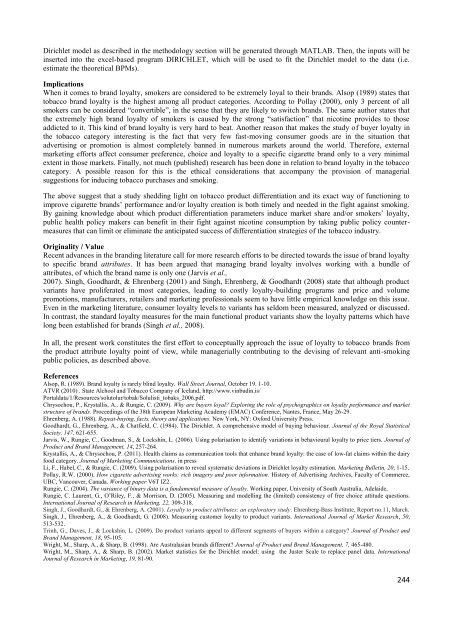Brand, Identity and Reputation: Exploring, Creating New Realities ...
Brand, Identity and Reputation: Exploring, Creating New Realities ...
Brand, Identity and Reputation: Exploring, Creating New Realities ...
Create successful ePaper yourself
Turn your PDF publications into a flip-book with our unique Google optimized e-Paper software.
Dirichlet model as described in the methodology section will be generated through MATLAB. Then, the inputs will be<br />
inserted into the excel-based program DIRICHLET, which will be used to fit the Dirichlet model to the data (i.e.<br />
estimate the theoretical BPMs).<br />
Implications<br />
When it comes to br<strong>and</strong> loyalty, smokers are considered to be extremely loyal to their br<strong>and</strong>s. Alsop (1989) states that<br />
tobacco br<strong>and</strong> loyalty is the highest among all product categories. According to Pollay (2000), only 3 percent of all<br />
smokers can be considered ―convertible‖, in the sense that they are likely to switch br<strong>and</strong>s. The same author states that<br />
the extremely high br<strong>and</strong> loyalty of smokers is caused by the strong ―satisfaction‖ that nicotine provides to those<br />
addicted to it. This kind of br<strong>and</strong> loyalty is very hard to beat. Another reason that makes the study of buyer loyalty in<br />
the tobacco category interesting is the fact that very few fast-moving consumer goods are in the situation that<br />
advertising or promotion is almost completely banned in numerous markets around the world. Therefore, external<br />
marketing efforts affect consumer preference, choice <strong>and</strong> loyalty to a specific cigarette br<strong>and</strong> only to a very minimal<br />
extent in those markets. Finally, not much (published) research has been done in relation to br<strong>and</strong> loyalty in the tobacco<br />
category. A possible reason for this is the ethical considerations that accompany the provision of managerial<br />
suggestions for inducing tobacco purchases <strong>and</strong> smoking.<br />
The above suggest that a study shedding light on tobacco product differentiation <strong>and</strong> its exact way of functioning to<br />
improve cigarette br<strong>and</strong>s‘ performance <strong>and</strong>/or loyalty creation is both timely <strong>and</strong> needed in the fight against smoking.<br />
By gaining knowledge about which product differentiation parameters induce market share <strong>and</strong>/or smokers‘ loyalty,<br />
public health policy makers can benefit in their fight against nicotine consumption by taking public policy countermeasures<br />
that can limit or eliminate the anticipated success of differentiation strategies of the tobacco industry.<br />
Originality / Value<br />
Recent advances in the br<strong>and</strong>ing literature call for more research efforts to be directed towards the issue of br<strong>and</strong> loyalty<br />
to specific br<strong>and</strong> attributes. It has been argued that managing br<strong>and</strong> loyalty involves working with a bundle of<br />
attributes, of which the br<strong>and</strong> name is only one (Jarvis et al.,<br />
2007). Singh, Goodhardt, & Ehrenberg (2001) <strong>and</strong> Singh, Ehrenberg, & Goodhardt (2008) state that although product<br />
variants have proliferated in most categories, leading to costly loyalty-building programs <strong>and</strong> price <strong>and</strong> volume<br />
promotions, manufacturers, retailers <strong>and</strong> marketing professionals seem to have little empirical knowledge on this issue.<br />
Even in the marketing literature, consumer loyalty levels to variants has seldom been measured, analyzed or discussed.<br />
In contrast, the st<strong>and</strong>ard loyalty measures for the main functional product variants show the loyalty patterns which have<br />
long been established for br<strong>and</strong>s (Singh et al., 2008).<br />
In all, the present work constitutes the first effort to conceptually approach the issue of loyalty to tobacco br<strong>and</strong>s from<br />
the product attribute loyalty point of view, while managerially contributing to the devising of relevant anti-smoking<br />
public policies, as described above.<br />
References<br />
Alsop, R. (1989). <strong>Br<strong>and</strong></strong> loyalty is rarely blind loyalty. Wall Street Journal, October 19. 1-10.<br />
ATVR (2010) . State Alchool <strong>and</strong> Tobacco Company of Icel<strong>and</strong>, http://www.vinbudin.is/<br />
Portaldata/1/Resources/solutolur/tobak/Solulisti_tobaks_2006.pdf.<br />
Chrysochou, P., Krystallis, A., & Rungie, C. (2009). Why are buyers loyal? <strong>Exploring</strong> the role of psychographics on loyalty performance <strong>and</strong> market<br />
structure of br<strong>and</strong>s. Proceedings of the 38th European Marketing Academy (EMAC) Conference, Nantes, France, May 26-29.<br />
Ehrenberg, A. (1988). Repeat-buying, facts, theory <strong>and</strong> applications. <strong>New</strong> York, NY: Oxford University Press.<br />
Goodhardt, G., Ehrenberg, A., & Chatfield, C. (1984). The Dirichlet. A comprehensive model of buying behaviour. Journal of the Royal Statistical<br />
Society, 147, 621-655.<br />
Jarvis, W., Rungie, C., Goodman, S., & Lockshin, L. (2006). Using polarisation to identify variations in behavioural loyalty to price tiers. Journal of<br />
Product <strong>and</strong> <strong>Br<strong>and</strong></strong> Management, 14, 257-264.<br />
Krystallis, A., & Chrysochou, P. (2011). Health claims as communication tools that enhance br<strong>and</strong> loyalty: the case of low-fat claims within the dairy<br />
food category. Journal of Marketing Communications, in press<br />
Li, F., Habel, C., & Rungie, C. (2009). Using polarisation to reveal systematic deviations in Dirichlet loyalty estimation. Marketing Bulletin, 20, 1-15.<br />
Pollay, R.W. (2000). How cigarette advertising works: rich imagery <strong>and</strong> poor information. History of Advertising Archives, Faculty of Commerce,<br />
UBC, Vancouver, Canada. Working paper V6T IZ2.<br />
Rungie, C. (2004). The variance of binary data is a fundamental measure of loyalty. Working paper, University of South Australia, Adelaide,<br />
Rungie, C. Laurent, G., O‘Riley, F., & Morrison, D. (2005). Measuring <strong>and</strong> modelling the (limited) consistency of free choice attitude questions.<br />
International Journal of Research in Marketing, 22, 309-318.<br />
Singh, J., Goodhardt, G., & Ehrenberg, A. (2001). Loyalty to product attributes: an exploratory study. Ehrenberg-Bass Institute, Report no.11, March.<br />
Singh, J., Ehrenberg, A., & Goodhardt, G. (2008). Measuring customer loyalty to product variants. International Journal of Market Research, 50,<br />
513-532.<br />
Trinh, G., Daves, J., & Lockshin, L. (2009). Do product variants appeal to different segments of buyers within a category? Journal of Product <strong>and</strong><br />
<strong>Br<strong>and</strong></strong> Management, 18, 95-105.<br />
Wright, M., Sharp, A., & Sharp, B. (1998). Are Australasian br<strong>and</strong>s different? Journal of Product <strong>and</strong> <strong>Br<strong>and</strong></strong> Management, 7, 465-480.<br />
Wright, M., Sharp, A., & Sharp, B. (2002). Market statistics for the Dirichlet model: using the Juster Scale to replace panel data. International<br />
Journal of Research in Marketing, 19, 81-90.<br />
244
















